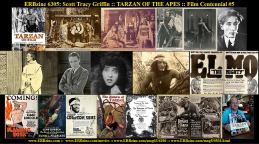
The First and Only Weekly Online Fanzine Devoted to the Life and Works of Edgar Rice Burroughs Since 1996 ~ Over 15,000 Webpages in Archive |

The First and Only Weekly Online Fanzine Devoted to the Life and Works of Edgar Rice Burroughs Since 1996 ~ Over 15,000 Webpages in Archive |
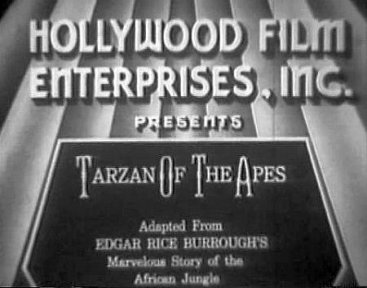
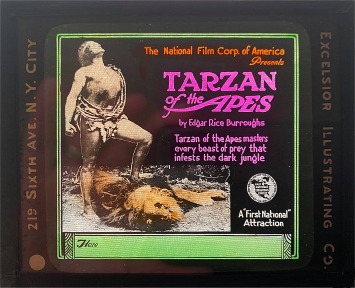
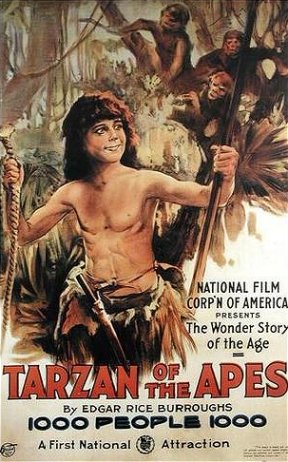
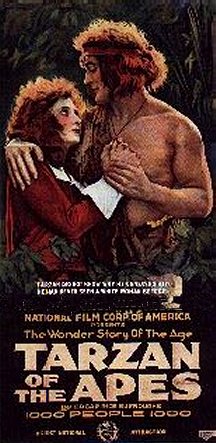
The first of a long line [of screen Tarzans] was Elmo Lincoln, the grand old man of the jungle. He brought Tarzan to the screen about seventeen years ago in Tarzan of the Apes and later appeared in the Romance of Tarzan and The Adventures of Tarzan. He had a tremendous following all over the world, and was nearly mobbed by small boys during his personal appearances and when he was recognized on the street. Because of his popularity, Elmo will always be the personification of Tarzan to many of that generation which knew him so well.
| Elmo Lincoln ~ Tarzan
Enid Markey Jane Porter True Boardman ~ John Clayton, Lord Greystoke Kathleen Kirkham ~ Alice Clayton, Lady Greystoke George B. French ~ Binns, a sailor Gordon Griffith ~ Tarzan, younger Colin Kenny ~ Greystoke's nephew Thomas Jefferson ~ Professor Porter Bessie Toner ~ Bar Maid Jack Wilson ~ Captain of the Fuwalda Louis Morrison ~ Innkeeper Eugene Pallette & Fred L. Wilson & Rex Ingram Stellan Windrow ~ Tarzan, tree-swinging (uncredited) Madame Sul-Te-Wan ~ Esmeralda (uncredited) Director: Scott Sidney
|
Runtime: Versions run from 55 to 120 minutes
Country: USA Color: Black and White Sound Mix: Silent Release Date: January 27, 1918 Production Company: National Film Corporation of America ~ USA
TECHNICAL SPECIFICATIONS
LOCATIONS:
|
The plot follows the novel more closely than does any other Tarzan movie. John and Alice Clayton take ship for Africa. Mutineers maroon them. After his parents die the newborn Tarzan is taken by a great Ape, Kala. Later the boy finds his father's knife and uses it to become King of Apes. Binns, the sailor who saved the Claytons and who has been held by Arab slavers for ten years, finds the young Tarzan and then heads for England to notify his kin. A scientist arrives to check out Binns' story. Tarzan, now a man, kills the native who killed Kala; when their chief is killed the black villagers appease Tarzan with gifts and prayers. The scientist's daughter Jane is carried off by a native, rescued by Tarzan (who has burnt the native village), aggressively loved by him ("Tarzan is a man, and men do not force the love of women"), and at last accepts him with open arms.
Plot Summary for Tarzan of the Apes (1918)
Internet Movie Data Base
IMDB Summary written by Ed Stephan stephan@cc.wwu.eduEdgar Rice Burroughs' story, Tarzan of the Apes, as a ten-reel screen feature produced by the National Film Corporation lacks much of the pep of the original. When Tarzan first appeared as a serial in "Evening World" there was no thought the story would have so widespread an appeal, but there was so much of a Rider Haggard atmosphere in the tale it attracted universal attention, and the "World" publication was followed by its re-publication in a popular fiction magazine and later in book form. Then followed several sequels, one of which was "The Return of Tarzan". After looking at the screen production and noting its ending it looks as thought the producers are prepared to shoot the sequel to this story, providing the initial Tarzan release "gets over". The chances are that it will do that, not because it is a great picture but mainly because it is an unusual feature. It is one of those pictures where the minor details will go a great way toward attracting and audience by word of mouth advertising. The occasional touches of the extraordinary are its greatest asset, and listed among these, not as the least, will have to be the work of Gordon Griffith, as Tarzan, a 10-year-old-boy. "Tarzan" in film is divided into three chapters, now being shown at the Broadway. The intermission occurs after the first two chapters. The running time is two hours and ten minutes, exclusive of the five minutes wait between the second and third chapters. The first and second chapters consumed approximately one hour and 20 minutes, with only the final 20 minutes holding anything like real action. The early sections are almost wholly devoted to planting the underlying theme of the story, which in the original was a secondary nature. Much time is devoted to the reason for the parents of Tarzan going to South Africa, also a tremendous footage is held by the succeeding holder of the title of Lord Greystoke, his escapades, marriage to a bar maid (Bessie Toner) and subsequent heir (Colin Kenny), while in the story the greater part of the action was devoted to Tarzan himself. It was "Tarzan of the Apes" in the original but in the film it might well be called "The Missing Heir" or something equally commonplace. All of the mystery, suspense, etc., conceived by placing this remarkable creature among the wild animals in the jungle and making him the conqueror of them because of his human brain and coupled with it the outdoor physical development of a jungle creature reared as an ape, is lacking. The reason is too much explanatory detail in the earlier portion of the film version. The story itself is generally known.
Synopsis from Variety, February 1, 1919The story itself is generally known. As the screen tells it Lord (True Boardman) and Lady (Kathleen Kirkham) Greystoke are in England in 1897, and all South Africa is in an uproar over the slave trade. Greystoke is delegated by Her Majesty to ferret out the inside of the slave trade and the secret diplomatic reasons for the African unrest. The final stage of his journey is on a sailing vessel, ruled by three brutal officers. Then a mutiny and the final disposition of the Greystokes by the crew. This is followed by their Robinson Crusoe existence; the birth of their child; the death of the parents and the adoption of Tarzan, the baby, by an ape who had lost her offspring. The film jumps ten years and it is 1907. Tarzan (Gordon Griffith) is 10 years of age. This is the second chapter, about equally divided between showing the development of the ape boy and the rearing of the son of the successor to the title in England. Then there is another leap, and Tarzan (Elmo Lincoln) is 20. He is "some" giant and has become King of the apes, while in England the heir apparent (Colin Kenny) is a dissipated youth who likes to mess around with mother's maid servants. But here is where the love interest is introduced. An American girl (Enid Markey) worth millions and fairly good looking comes on the scene. Mother says marry her, and he decides he will. But there is an expose. That a son of the Greystoke, who went to Africa, is living. It comes from an old sailor (George B. French). An expedition is organized and then in Africa Tarzan is brought on the scene again. He is the hero, rescues the girl and all that sort of thing. Finally he and the girl are shown seated on a tree trunk with he kissing her hand because she has called him down in perfectly proper English and he understood her (that is according to the subtitle), and then there is a fade out. None of the real mystery is cleared up, at least the mystery fostered in the picture. The audience is left in the dark as to whether or not he has come into his birthright, whether he has won the girl or not, or, if he has, did he keep her in the jungle wilds and how he learned English. These are four points in the dark. From a production standpoint the picture was evidently padded early through the medium of cutins of animal stuff. The ape family has been achieved by the medium of a flock of acrobats in skins and very foolishly a number of closeups are shown which kill the illusion. Otherwise from a production angle the picture is passable. As to cast, Elmo Lincoln as Tarzan at 20 is all that could be asked for, while Gordon Griffith as the boy is wonderful. It is admitted the producers must have had trouble in getting some one for the role of the ape-man, and in this particular they must be given full credit. But against that there is no one in the cast, with the exception of Geo. French who really does much worthy of comment. The cast is heralded as an "All Star" affair. Enid Markey is in it but she fails to register effectively. As for the others, Bessie Toner is not as young as when she was in "The College Widow" for the youthful bar maid and young wife. As the mother of a youth of 20 she was more at home. Special credit is given on the program to Isidor Bernstein for cutting and editing the picture. He should as that it be removed. It won't get him anything. "Tarzan of the Apes" is a freak picture that will cause talk, but needs cutting in the first hour and a half. When it is chopped for more speed and action and can be shown in an hour and a half it will be more worth while than at present.
Letters between Burroughs and his first agent, President of the International Press Bureau, 1913-1926, regarding the origin, serialization, distribution, publication, dramatization, and filming of Tarzan of the Apes, and other early Burroughs literary properties; the relationship concluding in a lawsuit between the two, Chapman the plaintiff seeking $5000 in damages, the two settling in Chapman's favor for $1000. With related correspondence, in nine binders. From Burroughs: 51 letters, 1 telegram, and one sheet with exchanges between the two on the same page. From Chapman: 218 retained carbons, 1 telegram, and the lawsuit documents. From McClurg, the Chicago publisher of Tarzan of the Apes and other early Burroughs titles: 27 letters, the pre-publication typed synopsis of Tarzan, and a typed statement of the sales of Tarzan. Additional related pieces included (complete list available upon request). The extraordinary and apparently complete (extant) revelation, from his agent's point of view, of the commencement of the publishing career of Edgar Rice Burroughs, from the very beginning, May 28, 1913, more than a year before the book publication by McClurg of Tarzan of the Apes, on June 17, 1914, to the end of the relationship between ERB and his agent. Between these dates, in more than 200 letters to Burroughs; syndicates which distribute for serial publication; publishers; stage play producers; and film companies, William Chapman performs the agent's duties with responsible and growing optimism, exhibited through understanding of the publishing practices of the time; while all along the way, "Burroughs," as he usually signed himself, is consistently terse, impatient, ever watchful, tight-fisted, and extremely productive. It would all fall apart when Burroughs challenged his agent's oversight of reprint rights and royalties, chiefly those monies derived from Tarzan of the Apes.
ARCHIVE OF ERB'S FIRST AGENT
WILLIAM GARRARD CHAPMAN
Put on sale to the public by Abe Books for US$62,500
The First Tarzan: Stellan Sven Windrow
February 9, 1893 Chicago - November 25, 1959 New York CityStellan Windrow's parents were both Swedish physicians, Sven Vindruvva and Anna Malmqvist Holm, divorced after emigrating to Chicago and giving birth to Stellan. Attended the University of Chicago where he took an Associate in Philosophy (1915) and was a member of Alpha Tau Omega, the Society of Tiger Head and the Blackfriars Drama Society. He was an outstanding college athlete (swimming, shotput, discus) Possessing a fine 1.93 m tall physique and fine looks, he worked summer jobs at Chicago's Essanay Studio where he became friends with Wallace Beery, Ruth Stonehouse and Francis X. Bushman. In 1917 he was hired by producer Bill Parsons to play Tarzan, becoming the first actor ever contracted for the part. Stellan Spent several weeks shooting the tree-work and jungle scenes on location in Bayou Teche, Louisiana Filming was interrupted by the United States entering World War I and Stellan immediate enlistment as an ensign in the navy. Stellan is rumoured to have entertained fellow soldiers on the ship ferrying them to Europe for WWI.by engaging in wrestling matches He attended the premiere of Tarzan of the Apes (1918) as a guest of Parsons, but was uncredited in the film despite having done all the location jungle scenes used in the film. The studio offered Windrow $1000 for a release so he wouldn't be credited in the film. Following his marriage to Marjorie Desborough in 1918, and the birth of daughters Marjorie and Patricia, the Windrows moved to a suburb of Paris, working for the Swedish division of Paramount Pictures. Swedish Filmography: 1.Halvvägs till himlen (1932) [Director] 2.Trådlöst och kärleksfullt (1931) [Production Manager] 3.Farliga leken, Den (1930) [Actor: Bob Dugan] 4.Hjärtats röst (1930) [Actor: Wells] ~ Source: IMDB In the late 1930s they returned to New York where he worked as a free-lance newspaper/magazine photographer. He served with the American Red Cross in north Africa during WWII. Stellan died of "hardening of the arteries" (Arteriosclerosis) on November 25, 1959 in New York.
FILM FACTOIDS Burroughs sold the film rights for Tarzan of the Apes to the National Film Corporation on June 6, 1916. He received a record $5,000 cash advance on royalties, $50,000 in company stock and five percent of gross receipts. NFC hired eight acrobats to play apes for which costumes made from goat skins and elaborate masks were constructed. Large amounts of artificial tropical vegetation and a portable log cabin were constructed for the sets. The original original choice to play Tarzan was a vaudeville actor, ukelele player Stellan S. Windrow, but before the film started he enlisted and left for the battlefields of WW1. Second choice Elmo Lincoln won the role when Windrow was drafted. Actress Enid Markey and child star Gordon Griffith were chosen to play Jane and the young Tarzan. Lincoln had an already established reputation as a Hollywood strong man due to his role as the Mighty Man of Valor in the 1916 DW Griffith classic "Intolerance." Lincoln was offered $75.00 a week for the role but held out for and received $100.00. Elmo Lincoln, born Elmo Linkenhelt, was an Arkansas peace officer when he went to work for D.W. Griffith who changed his name to Elmo Lincoln. Elmo went on to play in a Rayart serial of 10 chapters in 1927 called 'King of the Jungle'. He played the elevator operator in Tarzan's New York Adventure and a fisherman in Tarzan's Magic Fountain. Lincoln was stockier than Winslow and had trouble doing the sequences in the trees so they kept the footage shot of Windrow. Elmo weighed 210 pounds when he started making Tarzanbut lost 20 pounds making the picture. Elmo was 5' 11" tall. His normal chest measurement was 48 inches, but expanded to an extraordinary 53 inches. His chest was probably responsible for much of his fame in films. He literally acted with his chest. He could project defiance by breathing deeply after heroic deeds, or during love scenes. Elmo could gesture and perform with his chest the way other actors used their eyes and facial expressions. There's a popular myth around here that the 1918 version of "Tarzan of the Apes" was filmed on the northern shores of Lake Victoria. Not so. It was shot in Louisiana and California Over 300 local Louisiana negroes were hired as cannibal extras for $1.75 a day. Louisiana was chosen as the main shooting location because of the cooperation of the residents of Morgan City, the lush jungle vegetation, bayous, waterways, abundant black extras, and facilities such as hotels, a railway-serviced wharf and an adjacent storage warehouse. Sets, costumes and equipment were sent from Los Angeles by rail car. Additional ape costumes were made in Morgan City and twenty Young men from the New Orleans Athletic Club were hired to augment the "apes" brought from California. For the African village scenes native huts were constructed and 800 locals were hired as extras. The village was burned to the ground for the final village scene. Louisiana filming took place during August and September 1917. Interiors for Greystoke Manor, the log cabin and English inn were filmed on elaborate sets in the recently purchased Oz Studio in Hollywood A large schooner was leased for use in the ocean scenes. E and R Jungle Studio was leased for scenes requiring animals: lions, chimps, monkeys, etc. One of the shoots with the leopard caused a turmoil when a revolver shot frightened the animal and it escaped its cage to run loose on the set. The original length of the film was ten reels but later many of the English scenes were cut reducing the length to eight reels and much later approximately three reels more were cut for the video tape release. The film premier was at New York's Broadway Theatre on January 27, 1918 and its run was held over to April 2, 1918. The premier was ballyhooed with hundreds of posters and ad sheets, as well as huge billboards and banners on Broadway. The theatre lobby was done up as a jungle decorated with hanging moss, large tree boughs, and many stuffed animals, including the lion that Elmo had supposedly killed during production. Monkeys and apes swung through the faux foliage and theatre boxes while a 30-piece symphony orchestra provided a jungle-themed musical score. Similar displays were adopted by other theatres when the film opened nationwide. The Broadway premier, organized by Harry Reichenbach, was one of the most successful openings in history. Newspaper reviews were glowing describing the film as a daring spectacle, educational, an unusually entertaining picture, the most thrilling picture ever shown, a production nothing short of marvelous, and the greatest film of the age. An estimated 5,000 people were turned away for the first showing. New York's World newspaper serialized the novel during the film's New York run. Similar advertising and lobby promotions were employed when the film was released nationwide. Projected cost for the film of $100,000 rose to an estimated $250,000. The film earned over $1.5 ~ one of the first six films to gross over one million dollars. In November 1916 Ed was honoured with a membership card #1 in the Tribe of Tarzan. A club that has been formed by a fan in Virginia. Ed promoted the club in All-Story magazine. A later attempt to have the Chicago Herald promote the club was unsuccessful. The August-September 1918 McClurg's Bulletin promoted the Tribe of Tarzan club by reporting the rules and purposes of the club. They also note that the Tribe is successfully selling Liberty Bonds and is working in the Red Cross Thrift Stamp Campaign.
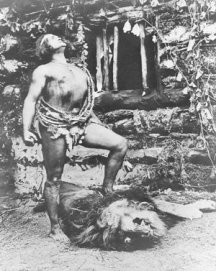
Elmo kills the lion
Truth or Myth? The legend is that in one scene a lion is supposed to crawl through the window of Tarzan's cabin to devour Jane. Tarzan grabs him and pulls him out. The old and drugged lion turned on Elmo Lincoln who stabbed and killed him. "I stepped on him to beat my chest. As my foot pressed down on him, the remaining air in his lungs escaped with a loud whoosh. I was already shaken and you should have seen me jump!" The lion supposedly wound up as a lobby display when the picture opened on Broadway.
Elmo's Version as told to Burroughs Bibliophile founder, Vern Coriell (Source: My Father, Elmo Lincoln by Marci'a Lincoln)
"I and a couple of other fellows tested for the part and I got it. The other candidates for the part disappointed the producer by falling out of trees. I asked for $100.00 a week for Tarzan. They wanted to pay me $75.00 Maybe someone else started the picture. . . but one day I received a telegram okaying the hundred I'd asked for and that was it."The only animal we had in the whole picture was "Old Charlie," a lion, and I killed him. Other a nimal footage was added to the film when it was edited. The lion I killed was in a scene where the lion was trying to get into a cabin to devour Jane. The lion was doped and tied up. I was supposed to jump on his back and stab him with a knife, but they gave me an old butcher knife to use and the damned thing broke when I tried to stab it.
The next day the tough hided old cat was doped again and they did a retake. That's when I started using a bayonet that I had filed down. This time I was successful in getting through the lions hide with the bayonet. The next scene was to show Tarzan with his foot on the dead lion and pounding his chest as he yelled his victory cry. Then he was supposed to leap across the lion. This caused the dead animal to make a sound which sounded like a roar. I thought "Old Charley" was still alive. I set a new record for the broad jump trying to get away.
Note: Vern Coriell doubted the accuracy of this story until he asked Enid Markey about it and she substantiated the whole thing. Another report has it that Enid Markey, who continued to work in film and TV into the 1960s, had no recollection of the event and it is possible that Lincoln concocted the story at a later date when he had fallen on hard times.
Producer William Parsons said that in the scene where Elmo's Tarzan fought the lion, the tranquilizer used to drug it seemed only to make the feline ferocious, and he attacked Elmo for real, as the cameras were rolling. According to this tale, Elmo battled the beast for his very life, finally killing it with his prop knife, all the while the impromptu battle taking place before the camera and crew remarkably remaining within focus. Elmo, with his experience with Griffith as a professional actor, allegedly did not ruin the shot but stayed in character, planting his foot on the dead lion and giving out a savage cry after he had slain the maddened beast. The scene is in the movie, and the story made good copy for the fan magazines.
ERB's Version:
Elmo had some thrilling experiences in the filming of Tarzan, and one surprise that he probably will never forget. In one of the scenes, a lion was supposed to be crawling through the window of a hut to devour the beautiful leading lady. Elmo grasped the lion by the tail, pulled it from the window and leaped upon its back. The lion was then killed, and in the next shot Elmo was supposed to place his foot upon its carcass and give the victory cry of the bull ape. He did it all except the victory cry, for as he placed his foot upon the supposedly dead body, the lion voiced terrific roar. In telling what happened immediately thereafter, Elmo says that he is positive that he holds the unofficial standing broad jump record.Actress Madame Sul-Te-Wan (birth name Nellie Crawford) was born in Louisville, Kentucky, on March 7th, 1873. She was the daughter of freed slaves Cleon De Londa and Silas Crawford. The father abandoned the family early on so her mother toiled as a laundress for a Louisville stage company. As a child, Sul-Te-Wan would watch the actors perform from a comfortable spot backstage which nurtured her dream of becoming an actress.
She got her start on the stage with a Cincinnati based theatrical troupe called The Three Black Cloaks. In the early days, she was billed as Creole Nell. Sul-Te-Wan later moved to the sunnier climes of California where she would find employment with director D.W. Griffith, appearing in "Birth of a Nation" (1915) and "Intolerance" (1916) and "Tarzan of the Apes" (1918)(uncredited). In fact, it has been said that she was the first African American to sign a contract with a major studio.
Sul-Te-Wan became an established character actress working alongside major stars like Tom Mix, Leatrice Joy, Matt Moore, Mildred Harris, Harry Carey, Robert Harron, Mae Marsh and Buster Keaton. She remained steadily employed in talking pictures, but was frustrated at the lack of substantial roles for African-American actresses. Madame Sul-Te-Wan passed away in 1959, at the age of eighty-five.
She later appeared in "Tarzan and the Trappers" (1958) as Witch Woman.
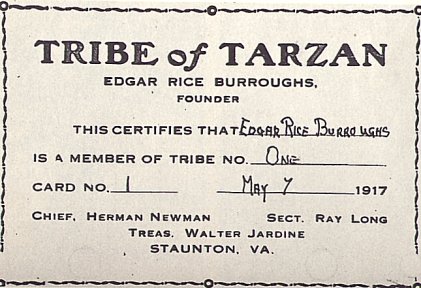

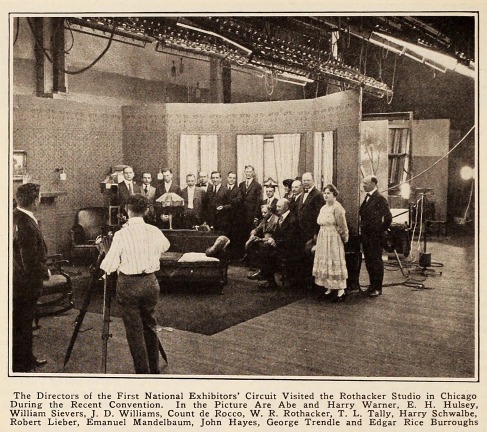
From the Ron de Laat Collection
Click for full size
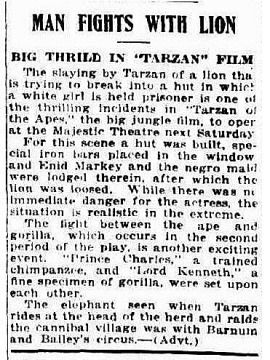
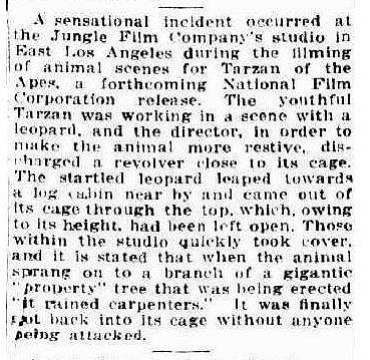
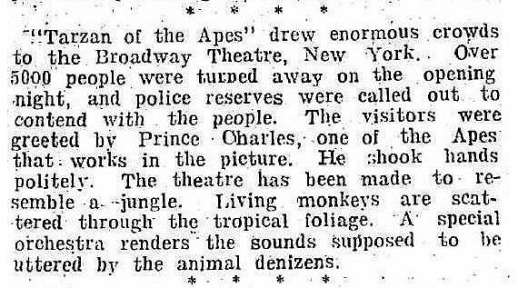
| January 16, 1918
Dear Mr. Burroughs: "Tarzan of the Apes" in picture form, based on your story, opens at the Broadway Theatre Sunday Evening, January 27. I would be gratified to have you present for the opening and will hold a box pending advice from you whether you will honor us with your presence that evening. Rex Beach, Irving Cobb, Woodhaven and all of the other boys in the Dutch Treat Club will be there and I will look forward to your being there. I have not seen the picture yet but am handling the exploitation of it and I am quite sure your presence will add to the dignity of the occasion. I have been talking to Mr. Parsons and everybody seems to report very enthusiastically on the picture and the fact that Mr. Parsons has given me "cart blank" in the matter of publicity, can make you rest assured that the story will suffer none at the hands of this Company. Kindly let me hear from you and also advise me if there is anybody in New York you would like me to forward invitations to, to the opening. Harry Reichenbach.
|
Many of the jungle scenes for Tarzan of the Apes were filmed near Morgan City, LA. Elmo Lincoln explained that a lot of the trees along the gulf were bent by the winds which stretched long lines of tree limbs close to the ground. "After the picture was released, people wondered how I managed to run through the trees and never be more than ten feet off the ground"
A MODERN DAY REVIEW: Tarzan of the Apes (VHS): Amazon.com video review
Instead of Jane, what this Tarzan really needed was the Jenny Craig of 1918 to come into his life. Elmo Lincoln was one overweight, overexposed fella as film's first Tarzan. It makes you wonder whether Jane Enid Markey, looking like a young Bernadette Peters) could really see. You might wonder if you need glasses, too, because the footage is grainy and filled with the herky-jerky movement associated with silent films. Overacted (in the broad, silent-film way), the movie serves as a sketchy introduction to the Greystoke myth. As there's no dialogue and you need to read titles to follow the story, you might have trouble convincing the kids to pay attention. (Tempt them instead with the first Tarzan talkie, and a classic, Tarzan, the Ape Man.) Still, the scenes of a young Tarzan playing gently with the monkeys and discovering his human form in the water's reflection are early inklings of more sophisticated storytelling that would follow. --Valerie J. Nelson
LOBBY DISPLAY
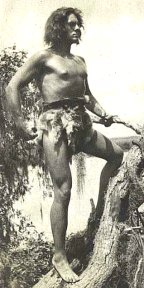
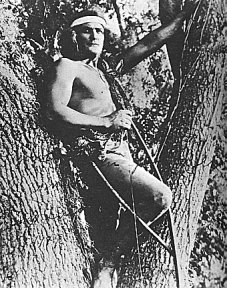
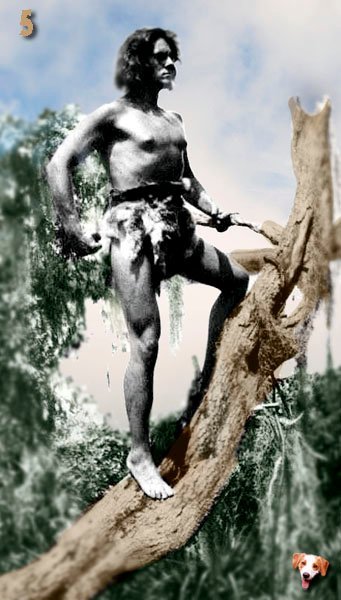
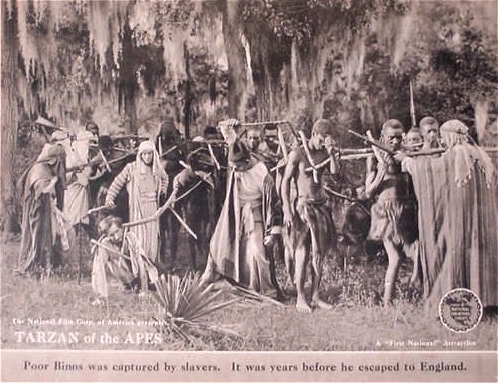
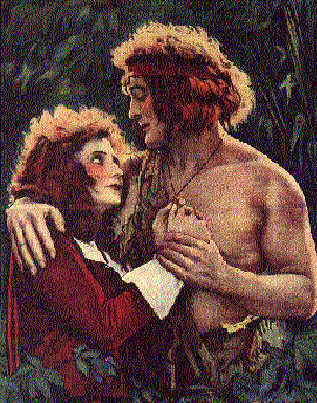
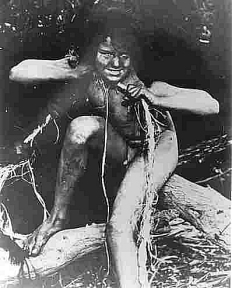
Gordon Griffith as 10-year-old Tarzan |
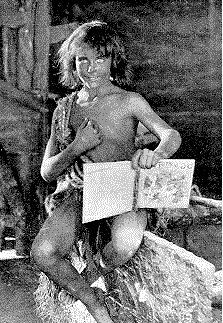
Young Tarzan teaches himself to read |
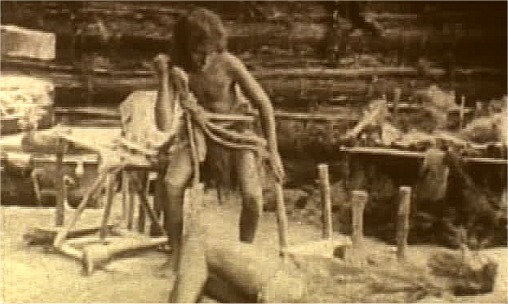
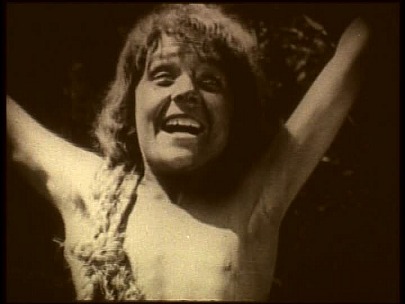
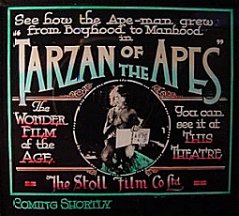
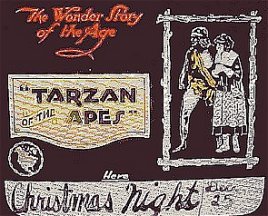

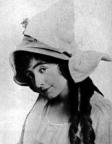
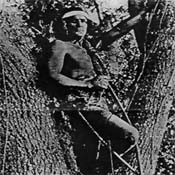
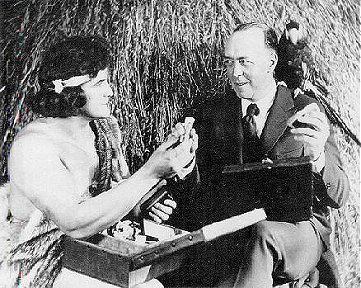
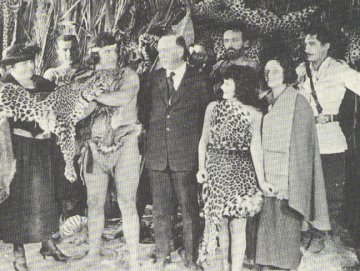
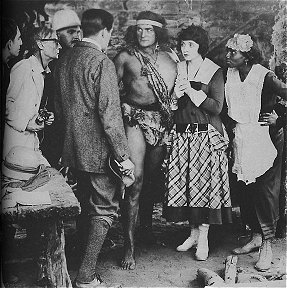
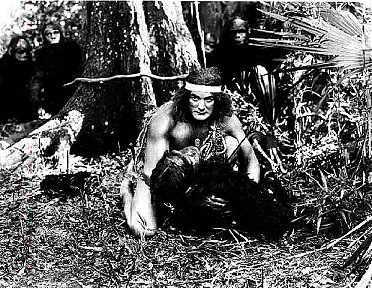
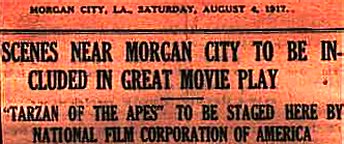

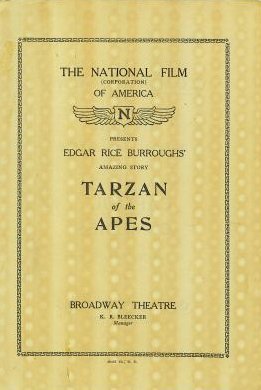
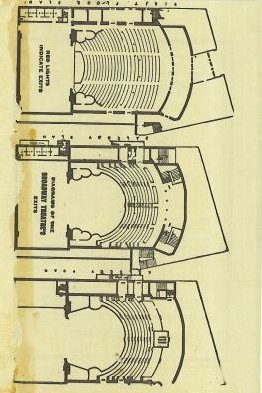
Tarzan of the Apes 1918 movie program from the Broadway
Theatre
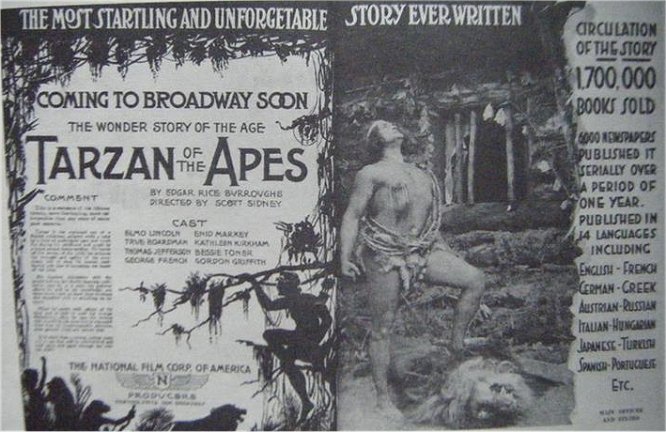
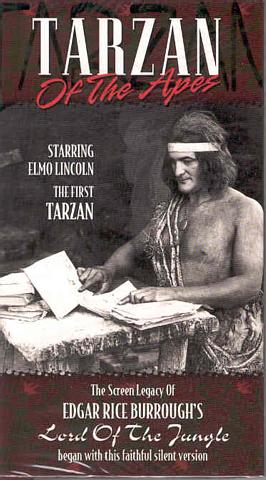 |
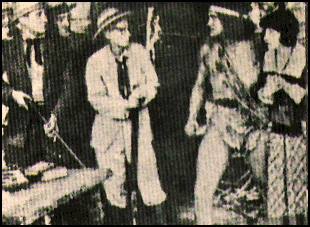
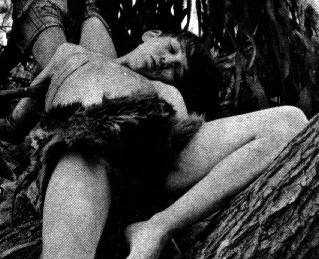 |
click for huge images
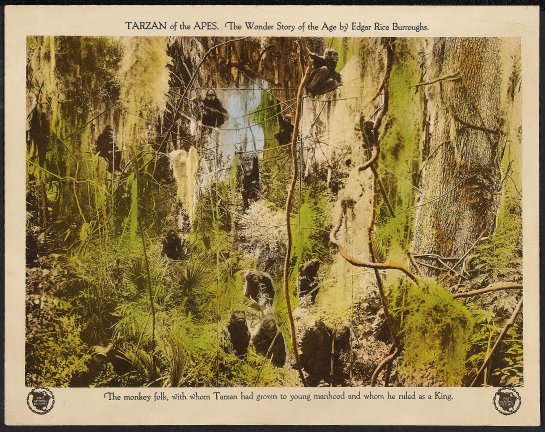
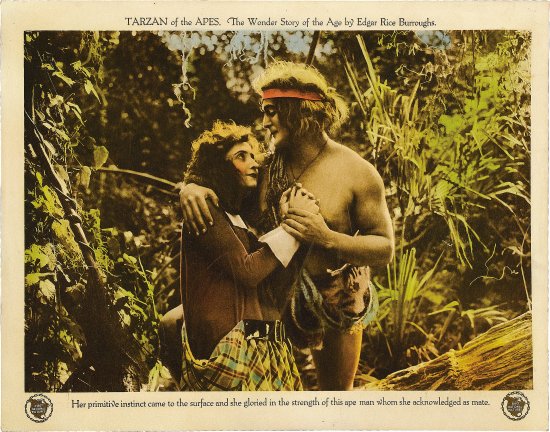
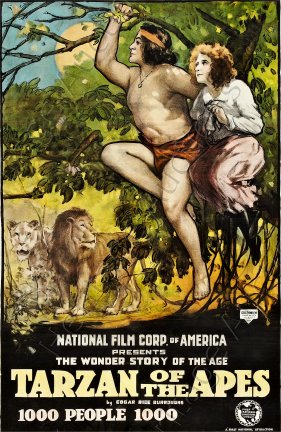
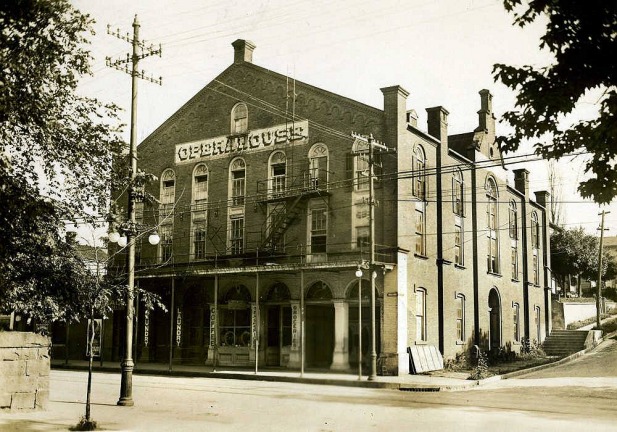
Photo Credit:
SE Missourian
"Tarzan of the Apes" (the poster is hard to see) was being screened
at the Cape Girardeau, Missouri Opera House in this 1918 photo!
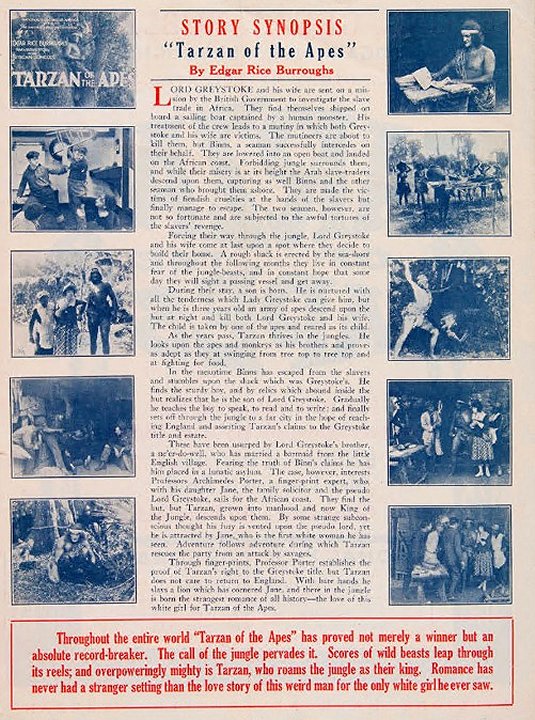
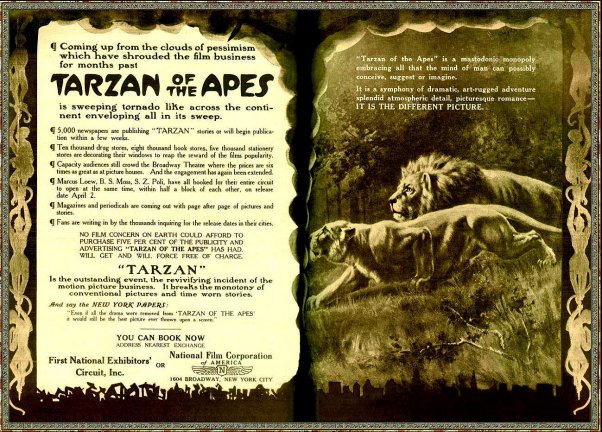
From the Danton Burroughs Collection thanks to Jerry
O'Hara
![]()
THE STELLAN WINDROW STORY
www.erbzine.com/mag28/2876.html
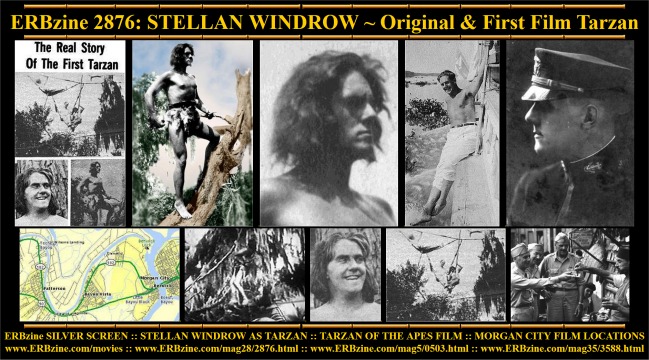
![]()
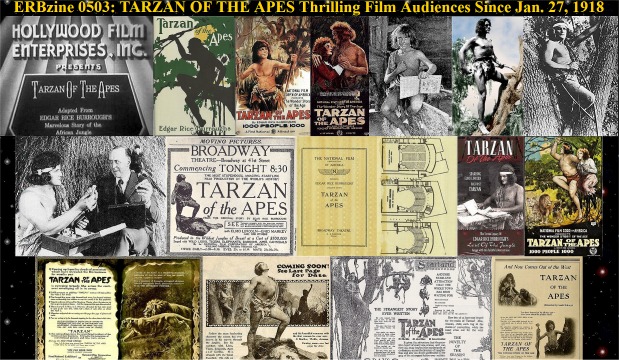
![]()
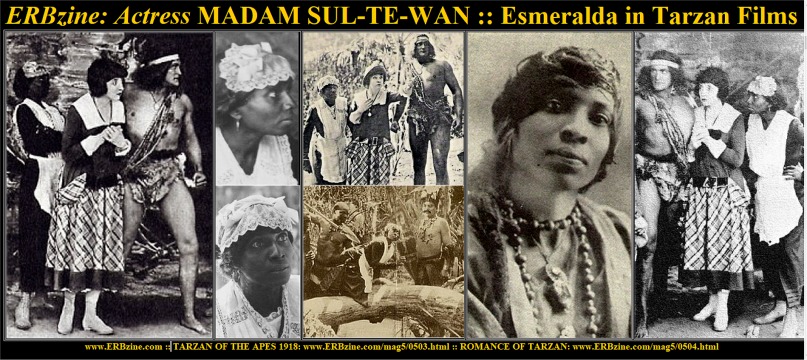
Click for full-size promo collages
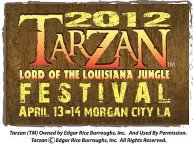
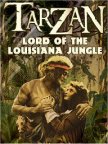
Visit to the original Louisiana film locations of 100 years ago
1. INTRODUCTION
AND CONTENTS
![]()
ENID MARKEY REMEMBERED IN THE PRESS
http://www.erbzine.com/mag29/2985.html
THE ENID MARKEY PHOTO GALLERY
From Tarzan's jungle, to a multitude of Hollywood
roles,
to the Broadway stage, to prime time television
http://www.erbzine.com/mag29/2985a.html
![]()
Celebrate the 100th Anniversary of Tarzan of the Apes
in film with
SCOTT TRACY GRIFFIN and his TARZAN ON FILM
![]()
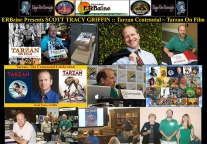
PART I www.erbzine.com/mag63/6302.html |
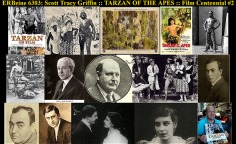
PART II www.erbzine.com/mag63/6303.html |
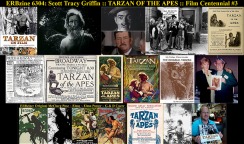
PART III www.erbzine.com/mag63/6304.html |
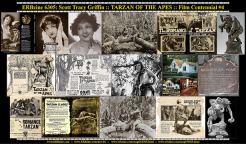
PART IV www.erbzine.com/mag63/6305.html |
